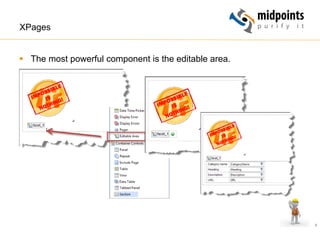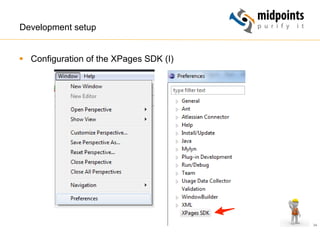Ad
UKLUG 2012 - XPages Extensibility API - going deep!
- 1. XPages Extensibility API – going deep UKLUG, September 2012, Cardiff René Winkelmeyer midpoints GmbH
- 2. About me midpoints GmbH http://www.midpoints.de IBM Advanced Business Partner IBM Design Partner for Domino Next IBM Mobile Design Partner Apple Enterprise Developer & MDM Program Samsung MDM Partner Services • Notes / Domino Consulting • E-Mail Management • App Development (IBM Connections, RCP, XPages, mobile, iOS, Android) René Winkelmeyer Senior Consultant We mobilize Notes • Lotus Traveler planning & deployment • mobile app development • Apple iOS Device Management with midpoints iOS.profiler • Secure Domino-based mobile content with midpoints doc.Store 2 OpenNTF Contributor and OpenNTF Director
- 3. • Skype muenzpraeger • Twitter muenzpraeger • LinkedIn muenzpraeger • Facebook muenzpraeger • Slideshare muenzpraeger • G+ www.winkelmeyer.com/+ • Web René Winkelmeyer http://blog.winkelmeyer.com Senior Consultant http://www.midpoints.de • Mail [email protected] [email protected] 3
- 4. I don‘t do XPages! I go deeper. 4
- 5. Agenda What will we talk about? - Differences XPages, Extension Library and Extensibility API - Starting with Plug-In-Development - Code examples - Deployment 5
- 6. Agenda What will we talk about? - Differences XPages, Extension Library and Extensibility API - Starting with Plug-In-Development - Code examples - Deployment 6
- 7. XPages § XPages is a great technology and expands our possibilities – from the point of administrators, developers and users. § Starting with XPages could be really simple. For the very first steps is just drag‘n‘drop, computing stuff and so on. § To be honest: Domino web development never was so easy (after you‘ve learned the basics) - even if it takes „slightly“ more time. 7
- 8. XPages § The most powerful component is the editable area. 8
- 9. XPages / XPages Extension Library § There are some things which aren‘t so easy... § You are missing controls in the pallette § OneUI ist too complex § You want some custom rendering § ... § Here the XPages Extension Library comes to your help. 9
- 10. XPages Extension Library 10
- 11. XPages Extension Library § IBM has introduced the XPages Extensibility API with Notes/Domino 8.5.2. § This API is a set of Java classes and methods which allow to integrate specialised functionality directly into XPages. § This means XPages in the browser and XPages in the Notes client. § IBM has used this API to provide the well-known XPages Extension Library – (first) on OpenNTF and than as part of the core product! 11
- 12. XPages Extension Library 12
- 13. XPages Extension Library § You‘ll finde it on OpenNTF http://extlib.openntf.org 13
- 14. XPages Extension Library § It‘s part of Notes/Domino 8.5.3 as „Upgrade Pack 1“ – full product support through IBM! § Part number: CI5GIEN § Watch out: If you want to use the Upgrade Pack 1 you‘ll have to uninstall previous versions of the OpenNTF Extension Library. § IBM installs the UP1 in the program directory. The OpenNTF components are installed in the data directory. § Currently only available as Installer – not as Updatesite. 14
- 15. XPages Extensibility API 15
- 16. XPages Extensibility API § It only makes sense to develop your own extensions if you need the same functionality across multiple applications. § An extension (aka OSGi Plug-In) needs only to deployed once per server or client – not per application. http://www.osgi.org <= start here 16
- 17. XPages Extensibility API § So called „artefacts“ can be added to the existing API during runtime. § JSF is an „open standard“ which APIs are publically available. § The XPages APIs are public since Domino 8.5.2. § Artefacts can be: § UI Controls § Converters § Validators § Data Sources § Simple Actions § Language Bindings § ... 17
- 18. XPages Architektur 18
- 19. XPages API Concepts § XPages Library § OSGi bundle, contains Java code, configuration files § Controls § Components which are available in the Designer pallette § Renderer § Renderer are responsible for displaying the output (HTML, CSS, ...) § Complex Types § Those are i. e. used to create encapsulated functions or store data. 19
- 20. Agenda What will we talk about? - Differences XPages, Extension Library and Extensibility API - Starting with Plug-In-Development - Code examples - Deployment 20
- 21. Powered By Eclipse 21
- 22. Eclipse Plug-In-Architektur 22
- 23. IBM Clients/Server based on Eclipse 23
- 24. Development setup § We are using Eclipse 4.2 (32bit) – definetly not recommended by IBM. 24
- 25. Development setup § For keeping it simple: use the OpenNTF project „XPages SDK for Eclipse RCP. § Nathan T. Freeman: http://www.openntf.org/internal/home.nsf/project.xsp? action=openDocument&name=XPages%20SDK%20for%20Eclipse %20RCP 25
- 26. Development setup § First create a new workspace 26
- 27. Development setup § Install new software in Eclipse 27
- 28. Development setup § Select the XPages SDK 28
- 29. Development setup § XPages SDK installation (I) De-select this check box 29
- 30. Development setup § XPages SDK installation (II) 30
- 31. Development setup § XPages SDK installation (III) 31
- 32. Development setup § XPages SDK installation (IV) § Unsigned means, that the plug-ins aren‘t digitially signed. That‘s ok. 32
- 33. Development setup § XPages SDK installation (V) 33
- 34. Development setup § Configuration of the XPages SDK (I) 34
- 35. Development setup § Configuration of the XPages SDK (II) 35
- 36. Development setup § Configuration of the XPages SDK (III) 36
- 37. Development setup § Configuration of the XPages SDK (IV) 37
- 38. Development setup § Configuration of the XPages SDK (V) 38
- 39. Development setup § Configuration of the XPages SDK (VI) 39
- 40. Development setup § Configuration of the XPages SDK (VII) 40
- 41. Development setup § You shouldn‘t develop without debugging. So we‘re installing a debugger. § We are using the OpenNTF Domino Debug Plug-In. § http://www.openntf.org/internal/home.nsf/release.xsp? documentId=CBF874E9C4607B4C8625799D00287B8C&action=openD ocument 41
- 42. Development setup § Installation of the Debug-Plug-In (I) 42
- 43. Development setup § Installation of the Debug-Plug-In (II) 43
- 44. Development setup § Installation of the Debug-Plug-In (III) 44
- 45. Development setup § Installation of the Debug-Plug-In (IV) 45
- 46. Development setup § Installation of the Debug-Plug-In (V) 46
- 47. Development setup § Installation of the Debug-Plug-In (VI) 47
- 48. Development setup § Installation of the Debug-Plug-In § Currently only local Domino server installations are supported. 48
- 49. Development setup § Creating the debug environment (I) 49
- 50. Development setup § Creating the debug environment (II) 50
- 51. Development setup § Creating the debug environment (II) 51
- 52. Development setup § Creating the debug environment (III) 52
- 53. Development setup § Add the following notes.ini parameters to the locally installed Domino server (they are needed for the remote debugging) § JAVADEBUGOPTIONS=transport=dt_socket,server=y,suspend=n,addr ess=8000 § JAVAENABLEDEBUG=1 53
- 54. Agenda What will we talk about? - Differences XPages, Extension Library and Extensibility API - Starting with Plug-In-Development - Code examples - Deployment 54
- 55. Code examples § A simple UIComponent created with the XPages Extensibility API Set the request scope Rendered with plug-in 55
- 56. General library structure § Java files § Controls § javax.faces.component.UIComponent § Base for all UI components § Renderers § javax.faces.render.Renderer § Writes the output to the browser § Configuration files § faces-config.xml § Runtime JSF configuration, defines i. e. the renderer § .xsp-config § Defines the controls, is used to display within Designer and for compiling the XPages § plugin.xml § Adding the extensions 56
- 57. Project structure 57
- 58. MessagesDialog (UIComponent for Designer) for identification 58
- 59. MessagesDialog (UIComponent for Designer) 59
- 61. MessagesRenderer (XPages output) helper method 61
- 64. Library Case-sensitive Designer (UIComponent) XPages (Renderer) 64
- 65. manifest.mf optional for JS addin 65
- 66. plugin.xml plug-ins library class 66
- 67. Configuration files § Simple till here...or? § Now we have to create the configuration files. Remember the standards! 67
- 69. messages.xsp-config 69
- 70. messages.xsp-config 70
- 71. messages.xsp-config 71
- 72. messages.xsp-config 72
- 73. plugin.xml für your own @Commands 73
- 74. Global Java definiton for your own @Commands 74
- 75. Detail class for your own @Commands 75
- 76. D-E-B-U-G-G-I-N-G § Setup a remote application for debugging. 76
- 77. D-E-B-U-G-G-I-N-G 77
- 78. Agenda What will we talk about? - Differences XPages, Extension Library and Extensibility API - Starting with Plug-In-Development - Code examples - Deployment 78
- 79. Deployment Domino-Server § Create a new database/application based on the Updatesite template. I highly recommend to use a dedicated database for server-only plug-ins in a production environment. § Import the plug-ins into the database. § Replicate the database with all according servers. § Plug-Ins couldn‘t be replicated as they „normally“ reside on the file system. § Set the notes.ini parameter OSGI_HTTP_DYNAMIC_BUNDLES=<database.nsf> on the Domino servers. § Finished. Restart the http and that‘s all. 79
- 80. Thank you very much! And thank you for excellent evals! :-D 80






































































































































































